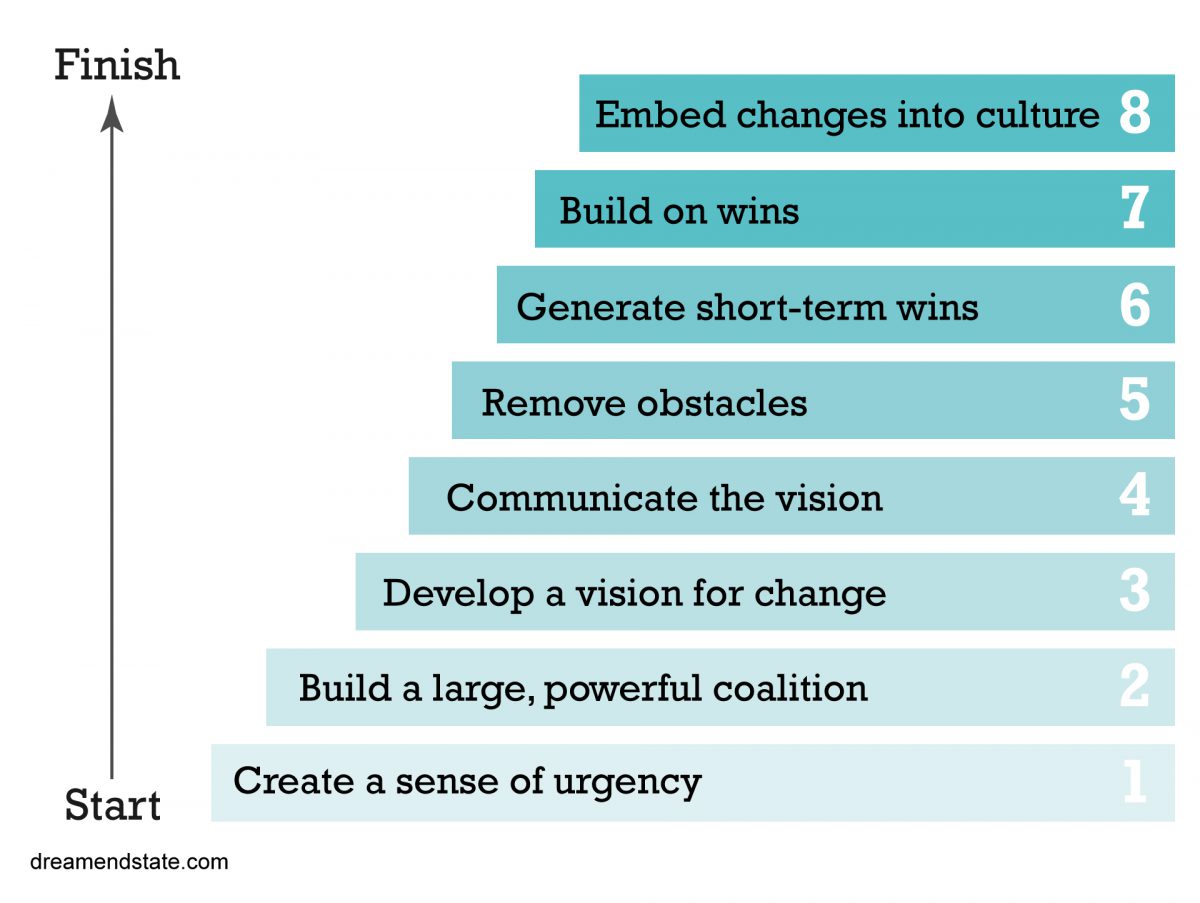Most major change programmes fail because of a lack of proper planning, according to John Kotter. He proposed eight steps to overcome this.
Kotter’s 8-step model of change management was first published in a 1995 Harvard Business Review article and followed up in his book Leading Change. His steps comprise:
- Create a sense of urgency
Find what’s going wrong or what needs to change and make it dramatic. A new competitor is a crisis, a new technology is a once-in-a-lifetime opportunity. Make a statement that communicates the importance of acting immediately. - Build a large, powerful coalition
One executive isn’t enough. Get the chairman, division managers and more on board. Build a coalition outside the normal business hierarchy — after all, if the corporate structure was working well, there would be no need for change. - Develop a vision for change
Go beyond the numbers and talk about a direction, a picture of what the future looks like and how it will be different from the past. It doesn’t have to be fully formed. Something that customers, investors and employees will understand and throw their weight behind. - Communicate the vision
This is about rallying the troops. One meeting isn’t going to do it. Make the vision part of everyday activities, appraisals and reviews, and make it exciting. Broadcast it through every channel. Leaders should walk the walk in everything they do. - Remove obstacles
These may come in the form of narrow job categories, a stubborn boss, or an incentive system that goes against the vision. - Generate short-term wins
This is not the same as hoping things go well. Plan what goals you’re going to reach and when, make them happen and celebrate them. Keep morale high to keep people on board. - Build on wins
Declaring victory prematurely kills momentum. Instead, use those short-term wins to tackle even bigger problems. Changes to corporate culture take at least five years to set in. - Embed changes into culture
Once you’ve transformed the corporate culture and values, make those changes stick. Show employees that performance improved because of the changes. Promote those who personify the new way of doing things.
Watch out for
Kotter said the two most important lessons from successful transformations are that they take a considerable length of time, and that failure in any one of these steps can be catastrophic.
He also argued that change requires leaders, not managers. (The book is called Leading Change, not Managing Change after all.) Leadership is “the engine that drives change”, taking risks and entering uncharted territory. Without disparaging the skill of management, the mindset of simply making things work as they are is doomed to failure when it comes to the transformation of a company.
Support from senior management is essential to any big change so make sure you have identified the stakeholders whose support you need, and make sure you dedicate the time and resources to persuade them to be strong advocates for your project.
With thanks to Ivan Edwards who wrote most of this post. Thanks Ivan!
Resources
Kotter, John P. (May 1995), Leading Change: Why Transformation Efforts Fail, Harvard Business Review
Kotter, John P. (November 2012), Leading Change, Harvard Business Review Press
Hamel, Gary & Zanini, Michele (October 2014), Build a change platform, not a change program, McKinsey & Company


Hi Paul!
I am currently a nursing student working on a professional change project that is using Kotter’s model of change. My group really likes the graphic created in this site and were wondering if you could give us permission to use it on a poster presentation?
Thank you for your time!
Hi Annabella — sure! That’s fine.